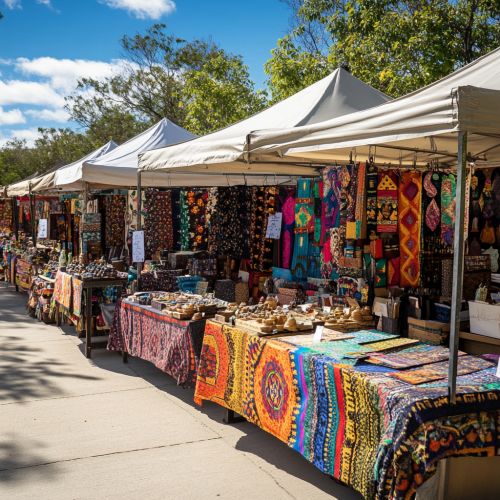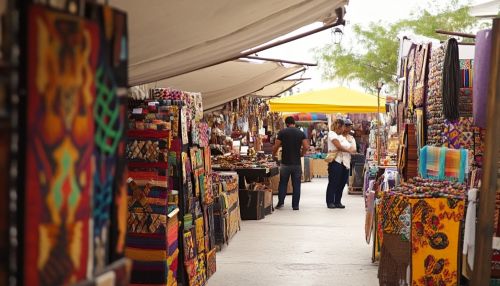Cultural and creative economies
Introduction
The concept of cultural and creative economies encompasses a broad spectrum of economic activities that are rooted in the cultural and creative sectors. These economies are characterized by their reliance on individual creativity, skill, and talent, and they have a significant impact on economic growth, employment, and social cohesion. The cultural and creative economies are diverse and include industries such as music, film, publishing, design, and the arts, among others. This article explores the various aspects of cultural and creative economies, including their definitions, components, economic impact, and challenges.
Definitions and Scope
Cultural and creative economies are often defined by their focus on the production and distribution of goods and services that are cultural in nature or require creative input. The UNESCO defines cultural industries as those that combine the creation, production, and commercialization of creative contents which are intangible and cultural in nature. Creative industries, on the other hand, are broader and include any economic activity that relies on individual creativity, skill, and talent.
The scope of cultural and creative economies is extensive, encompassing a wide range of sectors. These include traditional cultural sectors such as the performing arts, visual arts, and heritage, as well as newer sectors like digital media, advertising, and architecture. The boundaries between these sectors are often fluid, reflecting the interdisciplinary nature of creative work.
Components of Cultural and Creative Economies
Cultural Industries
Cultural industries are those that focus on the creation, production, and distribution of cultural goods and services. These industries include sectors such as music, film, publishing, and the performing arts. Cultural industries are often characterized by their reliance on intellectual property rights, which protect the creative output of individuals and organizations.
Creative Industries
Creative industries encompass a broader range of activities that rely on creativity as a primary input. These industries include advertising, design, fashion, and digital media. Creative industries are often at the forefront of innovation, as they frequently intersect with technology and other sectors to produce new products and services.
Heritage and Museums
Heritage and museums play a crucial role in cultural economies by preserving and promoting cultural heritage. These institutions contribute to cultural tourism and education, providing economic benefits to local communities. They also serve as important sites for cultural exchange and dialogue.
Digital and Media Arts
The digital and media arts sector is a rapidly growing component of the creative economy. This sector includes activities such as video game development, animation, and digital content creation. The rise of digital technologies has transformed the way cultural and creative content is produced and consumed, leading to new business models and opportunities.


Economic Impact
The cultural and creative economies have a significant impact on global and local economies. They contribute to economic growth, job creation, and innovation. According to the WIPO, the creative industries account for a substantial share of the global economy, with billions of dollars in revenue generated annually.
Employment
Cultural and creative economies are major sources of employment, providing jobs for millions of people worldwide. These jobs are often diverse, ranging from artists and performers to technicians and managers. The sector is also known for its high levels of self-employment and entrepreneurship, offering opportunities for individuals to start their own creative businesses.
Innovation and Competitiveness
The creative economy is a driver of innovation and competitiveness. Creative industries often lead the way in developing new products, services, and business models. They also contribute to the competitiveness of other sectors by providing creative inputs that enhance the value of goods and services.
Cultural Tourism
Cultural tourism is a significant component of the cultural economy, attracting visitors to cultural sites, festivals, and events. This form of tourism generates economic benefits for local communities, supporting businesses such as hotels, restaurants, and transportation services. Cultural tourism also promotes cultural exchange and understanding, enhancing the social value of cultural activities.
Challenges and Opportunities
Intellectual Property
Intellectual property (IP) is a critical issue for cultural and creative economies. Protecting the rights of creators and ensuring fair compensation for their work is essential for the sustainability of these industries. However, the digital age has brought new challenges, such as piracy and unauthorized distribution, which require innovative solutions and international cooperation.
Access and Inclusivity
Ensuring access and inclusivity in cultural and creative economies is a significant challenge. Barriers such as cost, location, and cultural bias can limit participation in cultural activities. Efforts to promote diversity and inclusivity are essential for broadening access and ensuring that all individuals have the opportunity to engage with and contribute to the creative economy.
Technological Advancements
Technological advancements present both challenges and opportunities for cultural and creative economies. While technology can enhance creativity and expand access to cultural content, it can also disrupt traditional business models and create new competitive pressures. Adapting to technological change is crucial for the continued growth and sustainability of the sector.
Policy and Support
Governments and international organizations play a vital role in supporting cultural and creative economies. Policies that promote investment in creative industries, protect intellectual property rights, and enhance access to cultural activities are essential for fostering a vibrant creative economy. Support for education and training in the arts and creative fields is also crucial for developing the skills needed for success in these industries.
International Cooperation
International cooperation is important for addressing the global challenges facing cultural and creative economies. Organizations such as UNESCO and WIPO work to promote cultural diversity, protect cultural heritage, and support the development of creative industries worldwide. Collaborative efforts can help to address issues such as piracy, cultural exchange, and the protection of cultural rights.
Conclusion
Cultural and creative economies are dynamic and diverse, playing a crucial role in economic growth, employment, and social cohesion. They encompass a wide range of activities and sectors, from traditional cultural industries to cutting-edge digital media. While these economies face challenges such as intellectual property protection and technological change, they also offer significant opportunities for innovation and cultural exchange. By supporting and investing in cultural and creative economies, societies can foster creativity, enhance cultural diversity, and drive sustainable economic development.
